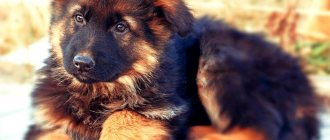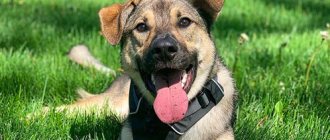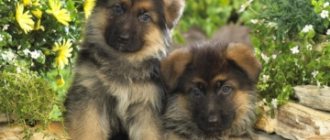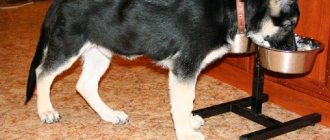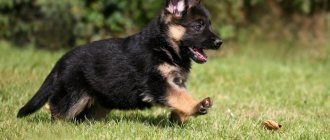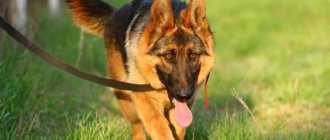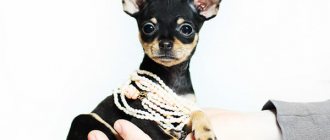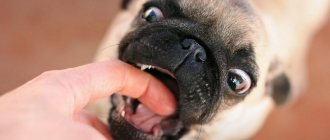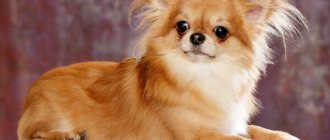The German Shepherd breed has long won the hearts of mankind.
They have all the qualities that a true friend needs.
Moreover, not a single patrolman or policeman can do without these dogs.
They are not only loyal friends, but also brave defenders who will do everything to save their owner.
So how do you choose a puppy?
Let's find out in detail from the article.
At what age are weaned from the mother?
Weaning too early can have a negative impact on the puppies' psyche . This moment must be timely, it must be chosen correctly.
Weaning should occur before the first vaccination . It is done at 2 months.
At 3-4 weeks, complementary foods are already introduced for puppies, which means that weaning from the mother should occur gradually by 5-6 weeks.
In order not to suddenly deprive the puppies of their mother's milk, it is allowed to let the puppies suckle at night. Over time, this too will have to be eliminated.
Weight by month
Newborn German Shepherd puppies weigh from 450 to 600 g. Receiving all the nutrients the body needs from their mother’s milk, they grow quickly, gaining weight from 50 to 100 g per day. At 1 month, a healthy baby should weigh from 2.5 to 4 kg, the height at the withers ranges from 19 to 23 cm. The wide range in weight is due to several factors:
- gender of the puppy (smaller females);
- number of heads in the litter;
- First-born bitches tend to have smaller puppies.
The one month old puppies are already walking well. Their eyes are open, their color may be bluish, but soon the color of the iris will change to brown. The eye shape is almond-shaped.
At 2 months, puppies weigh 7-9 kg. The babies are already confidently eating food, sucking less and less from their mother. This is the optimal age for weaning a puppy from a bitch and handing it over to new owners. At this age, the first vaccinations are given. At 3 months, the shepherd’s height reaches 40-44 cm and weight 14-17 kg. The puppy's owner unobtrusively begins raising the baby. By 4 months, the puppy should weigh 16-20 kg. The baby is active, runs and plays a lot. From this age you can start training your puppy.
What types of German Shepherds are there?
German There are several classifications to divide German Shepherds: by coat length, by color and by breeding line.
Types of German Shepherds by coat length:
- Short-haired. The coat of such shepherds is thick, short and close to the body. They have a good undercoat. The fur on the neck, tail and hips is longer than on the rest of the body;
- Long-haired. These dogs have soft, slightly wavy fur with an undercoat. The dog has a parting on its back. The especially thick coat on the neck and behind the ears, behind the ears and on the back of the paws forms feathering.
Crossing long-haired and short-haired shepherd dogs is prohibited . These are two different breeds, breeding records are kept separately.
Types of German Shepherds by color:
- Black. The rarest color for German Shepherds, only 5% have it. Black dogs of this breed are the real elite;
- Black and tan. The body is black, and the stomach and paws on the inside are light.
- Zonal. Each hair is colored in ring zones: light, then black, yellow, black.
- Black-and-white. The fur on the back is black, the belly, neck and limbs have tan markings of various colors: chocolate, reddish, yellow, fawn, gray. The muzzle is black or gray;
- White. A German Shepherd can be white if both parents have the recessive gene responsible for this color. In Canada, they even managed to develop a separate breed of such dogs.
The red color of the German Shepherd does not meet the standard, but this does not prevent it from becoming your pet and friend. This also applies to the gray color.
Types of dogs by breeding line:
- West Germany . It is a high breeding line. These dogs are best suited to the show standard. The dog's appearance was detrimental to its overall qualities. Such dogs are not suitable for official duties;
- Western operating lines - Czech/Slovak, East German , Dutch, Belgian . These dogs, on the contrary, have everything to become excellent service pets. They differ from their West German relatives;
- American line . The Americans focused on the appearance and ease of movement of the dog, because of this, their build is slightly different from their other brothers. American line dogs are balanced, calm and easy to train;
- English line . Their ancestors are sheepdogs brought to England in the mid-20th century. Over time, they were practically driven out of the island by their continental relatives.
Conclusions website
- The structure of the paws, chest and head of the German Shepherd is very harmonious, moderately massive, without unnecessary bends and bulges.
- The movements of a purebred dog are special - like an aristocratic dog.
- A purebred puppy grows faster than a purebred puppy and begins to remember commands faster.
- The shepherd's look is peculiar - too concentrated, smart and kind at the same time. The mongrel's eyes are almond-shaped and round.
- Without documents and a brand, it is extremely difficult to distinguish a German shepherd from a mongrel.
how to distinguish a German shepherd from a mongrel
- If you are not an expert, then no way. Guarantee of breed - a mark and a document of origin. If there is no pedigree, then most likely it is a shepherd-colored mongrel, because good purebred shepherd dogs are not bred without paperwork.
- based on the presence of a pedigree, that's all. Little Bestia, according to the German standard, the height for males is 60-65, for females it is generally 56-60, and for VEO it is just from 68 to 72
- no specialist will ever be able to tell a mongrel from a shepherd, only the person who has been with this breed for a long time, and especially at such a tender age, if they value blacks, then I’m definitely not judging from a shepherd by the white spots
- you can’t tell the difference if you’re not an expert) I agree with Tatyana,
here’s a photo of 1 German 2 yard terrier - they asked something similar: https://otvet.mail.ru/question/73311925/
- No way.
Don’t take this puppy and that’s it, or ask for documents from the parents, look at the bitch who sired the puppy. If it is important for you to have a purebred dog with a certain appearance and easy to train, find one with documents. You can always find it at a reasonable price. Very often, any large-sized dog is passed off as a shepherd, and then the devil will grow. Based on the parameters that they will write to you below, you will never be able to tell the difference. Massive paws, drooping croup - this is for the pros, the “breeder” will hang noodles on your ears, show you the skin, and prove that this is a massive backbone. If you yourself don’t understand the breed at all, only documents can help you, otherwise you will become another victim of scammers - Well, have you thought that you can’t tell a German from a mongrel???
- The German Shepherd is magnificent, extremely popular and perhaps the most numerous breed in the world. What is the reason for such success? In the German Shepherd everything is harmonious, rational and expedient. She is well trained, has a balanced character, and a stable nervous system. This is a self-confident, absolutely sincere dog, attentive and easy to control. She has courage, fighting instinct and toughness. She is noble, disciplined, intelligent, has strength, flexibility and subtle instincts. All this allows her to be one of the most reliable human companions. This is a service dog with a balanced, active type of behavior, exceptionally capable of a variety of training. The German Shepherd is most successful if it has one owner. She is able to unquestioningly carry out commands, even if it costs her life. The dog is not too large, with a strong, dry constitution and well-developed lean muscles. Besides that, she is very beautiful. Height at the withers: for males - 67-72 cm, for females - 60-68 cm. Another option: males - 60-65 cm, females - 55-60 cm. Weight about 28-35-40 kg. The skeleton is strong, massive, durable, but relatively light. The body is quite stretched (stretch index 110-112); The croup is smoothly lowered (the height at the rump is about 1-2 cm less). The typical gait is a low, creeping trot. The color is varied: zone-red and zone-gray in various shades: saddle cloth with various tones of the main background and saddle cloth; black and black with grey, red and brown markings. The color allowed is brown, fawn, brindle, white or white with yellow, as well as small white spots on the chest and fingers. There are shepherd dogs with steel-gray and ash coloring. The coat is thick, coarse, with a highly developed undercoat. The hair is tight-fitting, straight, relatively long (4-5 cm on the back); on the head, ears, front sides of the legs - shorter. The decorating hair does not stand out. There are also long-haired dogs, which is considered undesirable by some organizations - long hair covers the ears and legs, making them shaggy, forms a mane, feathers on the legs and dewlap on the tail. Also, depending on the coat, there is a division into three varieties of the German Shepherd: wire-haired, long-haired and long-haired. The skin is elastic, does not form folds or sagging. The dog's head is proportional to the body, long and dry, (when viewed from the front) wedge-shaped, massive, moderately wide in the skull, with slightly rounded cheekbones. The forehead is flat from the occipital protuberance, slightly convex in its anterior part. The transition from the forehead to the muzzle is smooth and unnoticeable. The line of the muzzle is parallel to the plane of the forehead, the muzzle is pointed, strong, slightly shorter than half the head. The lips are dry, tense, tightly fitting to the jaws. The lower lip forms a slight angle at its base. The nose is large and black. The ears are medium in size, wide at the base, erect, set high, with pointed ends, turned forward and directed upward. Puppies under 6 months of age may have slightly drooping ears. The eyes are oval-shaped (almond-shaped), medium-sized, slanted; dark or colored to match the color; with a lively, intelligent expression. The teeth are large and white. Scissor bite. The neck is strong, strong, dry, muscular, set at an angle of 40-45 relative to the line of the back, the length of the neck is approximately equal to the length of the head. The chest is oval, wide or not too wide; deep and long. The withers are muscular, high, and well defined. The back is straight and wide. The loin is short, muscular, slightly convex, blending imperceptibly to the croup. The croup is wide, rounded, muscular, smoothly descending to the base of the tail. The belly is moderately tucked. This is only half of what I found, just search the Internet, there’s a lot about them))))
- at his place. VHF paws are fleshy, large
- According to the documents!
You can learn how to choose a German Shepherd puppy and what points you need to pay attention to by reading this article. Choosing a good German breed puppy is quite a difficult task. This is due to the fact that recently the German shepherd breed has gained considerable popularity and, accordingly, demand. In this regard, some breeders sacrifice the quality of the breed in pursuit of the number of individuals.
You shouldn’t limit yourself to inspecting just the first puppy you like. If you still decide to choose a dog of this breed, then it is highly recommended to look at several options, since the first impression can be deceiving, and even champion puppies do not always look like their parents. It can be difficult to guess the future character and abilities of a puppy, because the fact that the parents were champions does not exclude the need to raise a future champion.
All German Shepherd puppies are cute and funny, but it is recommended that you look through several options to choose your pet.
At the same time, it is necessary to keep in mind that in order to win, the puppy also needs proper nutrition, and the owner needs knowledge of the characteristics and training skills. If a puppy is purchased to participate in various exhibitions, then you need to know that such a dog’s career may not last long, about 5-6 years.
How to distinguish from a mongrel?
Anyone can distinguish a purebred shepherd at 5 or 6 months from a mongrel, but not every buyer can do this at 1 or 2 months.
The main rules that will allow you to avoid being deceived:
- When purchasing, ask where the puppy’s parents are and ask to show them. Also find out what documents the parents have. To be 100% sure, you can call the Club and find out if these dogs are registered there;
- Puppies must be branded. The data on the stamp and in the metric must match;
- The puppy's eyes have an almond-shaped cut; when they turn their head, the white white is visible. Because of this, the eyes of the “German” are often compared to human ones;
- The iris can be from dark yellow to dark brown. The eyes may be blue for up to two months. Mutts have protruding, white, yellowish or speckled eyes.
- By the beginning of the shift, the shepherd dog should have 28 teeth. It is unacceptable for them to grow together or have an incorrect bite;
- The head of a purebred puppy should be proportional to the body. The forehead should not hang over the muzzle. There should be no beard between the eyebrows. The nose is black without a point. Lips in the color of your nose;
- Neck of medium length;
- The back is short and strong, the chest does not fall below the elbows;
- The tail should be long, it never rolls into a ring, and is always straight;
- The paws are large and large;
- The usual color of the German Shepherd is saddleback, but others are allowed. There may be a white martin on the chest, but spots inside it are not allowed;
- A purebred puppy will not be afraid of a person, but will try to follow any of his instructions - this is on a subconscious level. Mongrels avoid people. Also subconsciously.
Common arguments against:
It depends on how lucky you are with the puppy. However, the majority recognizes that yard dogs are healthier than purebred dogs, they undergo a kind of natural selection on the street, and the health of mixed breeds will be without breed-specific diseases. When buying a puppy of a rare breed, a situation of close inbreeding (incest) is possible, which is the cause of diseases. By purchasing a crossbreed, you are much less likely to end up with a nervous, sick animal than by purchasing a dog with eight champions in its pedigree.
- mongrels do not bond well with their owner and are ready to follow another person or simply run away. This is unlikely to happen if you are raising a puppy from an early age and have not adopted a fairly mature dog. Probably, due to their independent nature, the attachment of mongrel dogs to their owner may be less pronounced, but they are still human-oriented. Many mongrels are good apartment guards (however, their watchdog qualities are significantly inferior compared to service breed dogs), and they are faithful bodyguards.
- aggression
According to the results of surveys among dog owners, it turned out that most mongrel dogs are not markedly aggressive towards their own kind, but they are more aggressive towards strangers than boxers, giant schnauzers, East European shepherds, Dobermans and collies. In terms of their ability to develop an aggressive attitude towards a person as a possible enemy, mongrels and mixed breeds are inferior to recognized service dogs, but ahead of boxers, collies and Dobermans. If we understand unprovoked aggression as a danger to others, when, for example, a dog suddenly lunges at a passerby while walking, then mongrel dogs are more dangerous only than collies and Dobermans.
The manifestation of aggressiveness towards children - according to the degree of its decrease in a comparative series of breeds, looks like this: the most aggressive are Caucasian Shepherds, then Rottweilers, German Shepherds, black terriers, mongrels and mestizos, East European Shepherds, Collies, Giant Schnauzers, Boxers and Dobermans.
They don’t miss a single garbage dump. Fact. Haven’t you heard complaints from owners of purebred puppies that their curious puppies will not be happy to swim in the mud, rummage through a landfill, in search of some nasty stuff?...
What is the best age to buy?
Experts recommend taking puppies that have already been vaccinated, branded and weaned from their mother.
This is 3-4 months old . Some also take older Germans.
But you need to remember, the sooner you start raising a puppy, the greater your chances of success.
From the breeder you will receive the first recommendations on how to keep and feed your pet..
Where is the best place to buy - private owners, breeders, nurseries?
Your choice of location depends on the goals you are pursuing when purchasing a dog.
If you are interested in the exhibition and competition career of an animal, then you need a show-class pet that meets all standards and has all the documents on the breeding pedigree . In this case, you will have to fork out money and buy a dog in a kennel or from a breeder.
Breed-class dogs are most suitable for breeding, not exhibitions. You can also purchase such a puppy from the breeder.
If you just need a dog to spend time together, protect the territory, or for the soul, then a pet class is also suitable.
This type of shepherd dog can be bought from any private individual.
Expert opinion
Kozhevin Semyon Kirillovich
Expert dog handler.
“The right thing to do is to choose a place first. Before doing this, don’t be lazy, read reviews about the nursery or breeder. If you plan to take a puppy “from your hands”, be extremely careful, you risk choosing a “pig in a poke”. Look at what real German Shepherd puppies look like, at least on the Internet, get acquainted with their distinctive features, and then compare them with the dogs you choose from. If you have enough information in your head, you will never be deceived. Be persistent, ask, be interested. Often, even by the breeder’s reaction to questions, you can understand whether he is conscientious or not.”
Verification of documents
Checking the animal's documents is an important step in the process of purchasing a puppy. Not only the amount, but also the future life and health of the dog depends on them. The presence of metrics and a good pedigree will protect the new pet from many diseases and problems associated with breeding dogs and keeping them.
You should approach the choice of a puppy responsibly, since at this moment you are acquiring a friend with whom you will have to live for many years. The temperament of shepherds mixed with mongrels may differ from the standard, and therefore it is not recommended to take such risks. Determining whether an animal is purebred should be entrusted to a dog handler or a familiar breeder, since they have more information about the dogs.
Main rules - what to look for when buying
- Find out how many puppies were in the litter. If more than 10, then most likely the bitch had problems during childbirth and feeding;
- Look at the conditions in which the mother and puppies are kept, what they eat and where they sleep;
- Pay attention to the puppy’s appearance, its fatness and physical perfection;
- The puppy should not smell unpleasant, the mucous membranes should be clean;
- The forehead should not be too wide and the muzzle should not be pointed. Dogs have a scissor bite;
- The puppy should not fall while running; on the contrary, coordination should be good and there should be no lameness;
- The puppy's build should be proportional;
- Babies have coats without receding patches, most often saddle-colored.
The puppy's limbs should not be twisted, the tail of the German Shepherd should not be bent or crooked..
Is a pedigree necessary?
It is quite possible to buy a good puppy without a pedigree, which will be an excellent companion and guardian for the family. However, you need to understand that buying a dog without documents is always a lottery. There is no guarantee that a puppy will exhibit all the qualities inherent in German Shepherds. The situation with hereditary diseases in such dogs may also not be happy. Often, in an effort to get more litters from one bitch, a dog is bred more than once a year. As a result, the offspring are weak and sickly.
What does a healthy puppy look like?
A healthy German Shepherd puppy looks like a little bear.
NOTE!
The paws should be wide and compact; when looking at the dog from the front, its front paws and chest should form the letter A.
The back of puppies is smooth, dense and without any deflections.
The baby should have a wide pectoral girdle, their chest is deep . There should be no fifth toes on the hind legs - this is a defect. Also, the paws should not have any bumps. The tail is long and straight.
There should be no stiff ends on the ears - this indicates an excess of calcium, such ears may not stand up in the future. Blue eye color is allowed in the first months, then it begins to darken. At the same time, there should be no discharge from the dog’s eyes and ears.
Healthy puppies have no damage to their skin . It is elastic and soft.
Definition
German Shepherd
- a dog bred at the end of the 19th century in Germany as a service dog based on the Central and South German varieties of guard breeds, a descendant of the northern wolf. According to the FCI classification, it belongs to Group 1 – herding and cattle breeding. A self-confident, well-managed, good-natured dog with strong nerves.
German Shepherd
Cur
– a dog that has not belonged to any breed for several generations, often homeless. Due to strict natural selection, it has good health.
First of all, it should be said that you need to study the breed standard very well before buying a dog. It is very difficult for a non-professional to distinguish a German Shepherd from a mongrel. But at least some conclusions can be drawn.
Cur
Assessment of mental and other abilities
To determine the intellectual abilities of a German shepherd, a special test by zoologist William Campbell has long been used.
It helps determine:
- The puppy's desire to communicate;
- Its ability to follow its owner;
- Puppy obedience level;
- The desire for dominance;
- Self-esteem.
But such a test can be carried out by a breeder or specialist, but you can only assess the general capabilities of the puppy.
Look at the parents and determine if they have cowardice, aggression or hysteria - this can be passed on to the puppy. The baby should be a curious little explorer.
If timidity in a puppy is also explained by the fact that it can suffer aggression from other brothers, but cowardice is not allowed in this breed.
The puppy should not be afraid of you, noise, not at all, he will be interested in sniffing and getting to know a new person.
The puppy must be socialized and communicate well with its other brothers and mother.
This will make your parenting task easier.
In general, the baby German Shepherd is lively and inquisitive, he is interested in exploring the world, showing interest in new things.
Let's compare both breeds
To get as close as possible to the answer: which of the two pets is stronger, we will analyze each breed separately and compare them with each other.
Exterior
First, let's look at the external characteristics of both breeds.
Doberman:
- The Doberman has a large and muscular build. The height at the withers is slightly greater than that of shepherd dogs - in females it reaches 68 centimeters, in males up to 72 centimeters.
- The weight is also slightly different. Female Dobermans weigh up to 35 kilograms, and male Dobermans weigh up to 45 kilograms.
- Their coat is quite short and does not contain undercoat. It is polished, has a rigid structure and does not curl.
- The coat color is mainly charcoal, with small brown and red spots.
- The muzzle of representatives of this breed is elongated, the eyes are dark and round in shape, the ears are erect, and they are often cropped.
- The tail is also short due to docking. The back is straight, the sternum is wide.
- The neck is elongated and thick.
- The limbs are straight, parallel to each other.
- The claws are long and dark in color.
Shepherd:
- The Shepherd also has a proportional build. The height of males reaches 65 centimeters at the withers, females - up to 60 centimeters. However, Dobermans are taller. Shepherd girls weigh up to 32 kilograms, boys - up to 40 kilograms.
- The coat of German Shepherds can be short or long and has a pronounced undercoat. She is straight and tough.
- The color of the fur coat can be of different shades: ranging from coal-black, saddle-back with red and gray spots to zone-red or zone-gray.
- The mouth is slightly shorter than that of Dobermans, the nose is black. The muzzle itself is dark in color.
- The eyes are oval and have brown or black shades.
- The chest is wide and muscular.
- The back is flat and often black.
- The limbs are straight and parallel to each other.
The character of the Doberman is distinguished by playfulness and friendliness, and not anger, as everyone is accustomed to think. The Doberman is a very sensitive and loyal animal with a peculiar disposition. They are independent, sometimes too independent.
Such pets instantly react to the slightest manifestation of aggression and are able to rush into battle without sparing themselves. Representatives of the Doberman breed show aggression only if the owner or members of his family are in danger and someone is making an attempt on their life. However, they behave well with other pets and get along well with them. Dobermans are calm towards small children.
As for the German Shepherd, its character and behavior are slightly different. This animal cannot live without a person and his attention. The Shepherd has a calm disposition and a balanced psyche. If the dog notices that someone is trying to harm the owner, it will immediately begin to protect him.
In a family, she usually chooses one leader, listens to him unquestioningly and is faithful to the person until the end of her days. In addition, shepherd dogs are friendly towards small children and are able to play the role of a nanny for them. They treat cats calmly, but they may not get along with some dogs.
Attitude to training
Of course, any breed needs to be raised and trained. This is especially true for Dobermans. But when training these pets, you need to show ingenuity and a special approach. Sometimes Dobermans can be stubborn and play around without listening to their owner.
However, their learning abilities are very great. Of course, they need to be constantly improved. The Doberman, as mentioned above, is a very sensitive pet; it can sense the owner’s mood and mirror his behavior.
The German Shepherd behaves completely differently when trained. She carefully and easily follows commands and remembers them well. However, if you abandon training, the dog will forget everything completely, and training will need to start all over again.
Therefore, the shepherd’s brain requires constant mental work, and physical activity is required to maintain muscle tone. The Shepherd always unconditionally listens to the one he has chosen as an authoritative owner.
Compatibility test
The puppy should suit your temperament and character. Therefore, play with him, observe how he behaves around his brothers. Also, it would not be amiss to conduct several tests with him in order to understand what character traits the puppy already has.
IMPORTANT!
See if he runs up to you as soon as you leave him, if he follows your call, how much he is subject to submission and dominance - to do this, turn him over on his back and try to hold him in this position, stroke him and look at the reaction, take him hold him in your arms and observe his behavior - whether the puppy can remain at a distance from the ground in your hands.
Based on the puppy’s reaction, draw conclusions about what he will become and whether you need a pet with such a character.
Who to choose - a boy or a girl?
Boys always have better conformation and are more successful in exhibitions. This is also due to the fact that females are subject to estrus twice a year, which means pregnancy and childbirth.
The latter factors are also worth keeping in mind when choosing a dog.
Do not forget that the male will also need the bitch, but all the consequences fall on her.
If you plan to make a show career, choose a male; a female is more suitable for breeding.
Otherwise, only the owner can choose which gender of pet he prefers.
